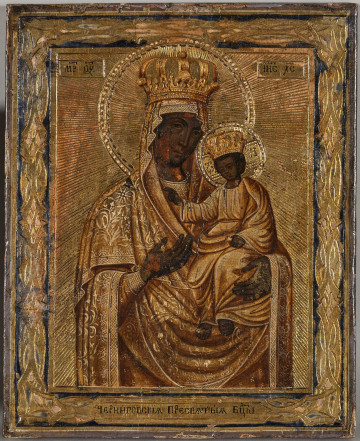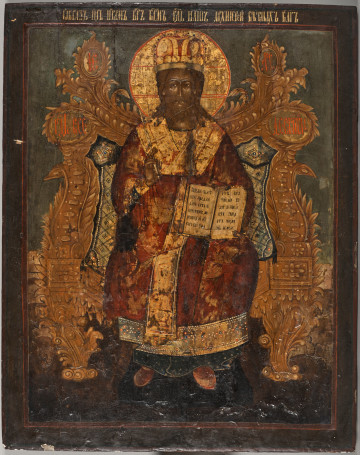
The Mother of God of Hodigitria
19th (?) century
Castle Museum in Łańcut
Part of the collection: Ikony
Crucifixion, silhouette icon In the Rus, crosses are among the oldest and most commonly used objects of Christian worship from birth to death. One baptised and blessed with a cross, swore on a cross, travelled, healed, and buried with a cross. The cross was passed down from generation to generation. For this reason, crosses made of metal alloys were very popular (see S.12789MŁ – 12795MŁ; S.12869MŁ – 12873MŁ; S.12875MŁ – 12876MŁ). In addition to the image of the Saviour, representations which supplement the content of the depiction appear on the cross. According to the evangelical message, these are, among others, figures accompanying the Crucifixion: the Mother of God and Martha (the Gospels mention several women) as well as the youngest disciple of Christ - St. John the Evangelist, known as the Theologian and the convert centurion Longinus. In the older tradition, their half-figures were placed on the ends of the central beam, by Christ's hands (see S.12789MŁ; S.12870MŁ) or their full standing figures were placed next to the vertical beam of the cross, at the base. In the perfected metal forms of the crosses of the Old Believers, who did not accept the liturgical reform of the Patriarch Nikon in the middle of the 17th c., the figures accompanying the Crucifixion began to be arranged on plaques located on both sides of the cross, as on the displayed exhibit. They were given the colloquial name 'połotienca' meaning 'towels', since the crosses, which were highly respected among the Old Believers, were decorated with embroidered towels, the ends of which hung on both sides of the cross. Individual communities of Old Believers attached great importance to the depictions placed on the crosses. Communities of Priestless Old Believers ('Bespopovtsy') only recognised the older image of the Mandylion (S.12864MŁ) at the top of the cross, and they did not recognise the ИНЦИ form describing the Saviour. Crosses cast from metal were often set in hollowed-out areas in wooden canvas boards, where, together with other metal icons, they formed distinctive iconostases, commonly called staurothekes (see S.12828MŁ). Teresa Bagińska-Żurawska https://orcid.org/0000-0002-9243-3967
Dimensions
height: 16.3 cm, width: 10.6 cm
Object type
Icons
Material
varnish enamel
Origin / acquisition method
decyzja administracyjna
Creation time / dating
Creation / finding place
Owner
Castle Museum in Łańcut
Identification number
Location / status

19th (?) century
Castle Museum in Łańcut

1800 — 1850
Castle Museum in Łańcut

1800 — 1899
Castle Museum in Łańcut
DISCOVER this TOPIC
National Museum in Lublin
DISCOVER this PATH
Educational path